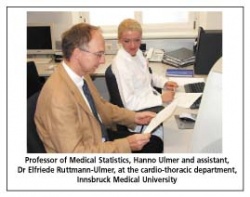Test could reveal CD death risk

Enzyme measurement may predict risk of dying from cardiovascular disease
A simple blood test may identify people who have an increased risk of dying from cardiovascular disease, according to research published in Circulation: Journal of the American Heart Association. The test measures gamma-glutamyl transferase (GGT) - an enzyme produced primarily by the liver - and catalyses glutathione, the main antioxidant in the body. The enzyme is elevated in some forms of liver disease, so physicians use GGT levels to detect liver damage and alcohol abuse.
Analysing data from a long-term study involving over 160,000 Austrian adults, the researchers found that the higher a person’s blood level of GGT, the greater the risk of cardiovascular death. The levels are given in units per litre (U/l) of blood. Normal low is less than 9 U/l for women and less than 14 U/l for men. A moderately high value for GGT is 18 U/I for women and 28 U/I for men. High levels (two-fold elevated) are more than 36 U/I for women and 56 U/I for men.
‘People with high GGT had more than a 1.5-fold risk of dying from cardiovascular diseases in comparison to people with normal low levels of GGT,’ said Hanno Ulmer PhD, senior author and associate professor of medical statistics at the Innsbruck Medical University. ‘For people under 60 years of age, this risk is even higher, amounting to more than two-fold. Over the past decade, some small studies have suggested a link between high GGT and cardiovascular disease.’
Several years ago, Italian researchers reported that elevated GGT could indicate early atherosclerosis. Dr Ulmer and his colleagues investigated those findings, examining medical data collected from 1985-2001 from 163,944 (98.4%) of the then-enrolled volunteers in the Vorarlberg Health Monitoring and Promotion Programme - an ongoing study in Austria’s westernmost province that examines risk factors for chronic diseases.
The participants included 74,830 men and 89,114 women, aged 19 or older when they entered the study, and had been followed for an average of 11 to 12 years.
After controlling for known cardiovascular risk factors, the team found that GGT was an independent predictor of fatal heart disease or stroke.
Other key findings in the study:
• At enrolment, 21.9 percent of men and 15.6 percent of the women had elevated GGT.
• Of the 6,990 deaths that occurred among the volunteers, 43.3 percent resulted from heart disease or a stroke.
• Among all men, the risk of cardiovascular death was 28 percent higher for those with moderately high GGT, compared to men with normal levels of the enzyme, and rose to 64 percent for those with highly elevated GGT. In women, the increase in risk ranged from 35 percent to 51 percent.
• In men, elevated GGT had a statistically significant association with death caused by chronic coronary heart disease, congestive heart failure, ischaemic stroke (caused by a blocked artery in the brain), and hemorrhagic stroke (caused by a ruptured blood vessel in the brain). Researchers found no significant correlation with acute heart attacks caused by a blocked artery, sub-acute coronary heart disease, or other cardiovascular disease.
• Women with elevated GGT had an increased risk of death from all cardiovascular diseases. However, the association with hemorrhagic and ischaemic strokes was not statistically significant.
• GGT proved a strong predictor of cardiovascular death, third behind smoking and hypertension but ahead of high levels of blood sugar, cholesterol and triglycerides.
Ulmer cited two mechanisms that might explain why GGT can indicate cardiovascular disease. The first, originally proposed by the Italian researchers, is that high GGT shows the presence of atherosclerosis. The second is that it’s related to the ill effects of heavy drinking on blood vessels.
‘Beyond its role as an indicator of liver function, GGT is very likely to predict cardiovascular disease,’ he said. ‘Since GGT is correlated with established risk factors, the known ways of preventing the disease might also be effective in lowering GGT levels.’
Because the study participants were overwhelmingly white Austrians, the team could not say whether their findings hold true for other racial and ethnic groups.
‘Both epidemiologic and experimental studies should be performed to confirm these findings, Dr Ulmer suggests. ‘GGT should be included as a major parameter in future cardiovascular intervention studies’
In an accompanying editorial, Michele Emdin MD, of the cardiovascular medicine department at the National Research Council, in Pisa, Italy, wrote that elevated GGT might help identify people with ‘the most risky combination for the vulnerable plaque, and the best medical strategies for the stabilization of lesions, rather than percutaneous or surgical.’
(* Study co-authors: Elfriede Ruttmann MD; Larry J Brant PhD; Hans Concin MD; Gunter Diem MD; and Kilian Rapp MD).
02.08.2006











